The Molecular Model of Organic Matter in Coal-Measure Shale: Structure Construction and Evaluation Based on Experimental Characterization
Abstract
1. Introduction
2. Result and Discussion
2.1. Elemental Analysis, 13CNMR, and FTIR Data
2.2. Construction of 2D Molecular Model
2.3. Construction of 3D Macromolecular Model of OM
2.4. Pore Structure
OM Pores in the FIB-SEM/HREM Images
2.5. The Adsorption Capacity of the 3D OM Model
3. Sample and Methods
3.1. OM Isolation
3.2. OM Chemical Structure Analysis
3.2.1. Elemental Analysis
3.2.2. 13CNMR Experiment on the OM
3.2.3. XPS Experiment on the OM
3.2.4. FTIR Experiment on the OM
3.3. Characterizing Pore Structure of Samples
3.3.1. Gas Adsorption and Helium Density Test Experiments
3.3.2. FIB-SEM Observation on Shale Sample
3.3.3. TEM Observation on OM Sample
4. Conclusions
Author Contributions
Funding
Institutional Review Board Statement
Informed Consent Statement
Data Availability Statement
Acknowledgments
Conflicts of Interest
References
- National Energy Administration. China Natural Gas Development Report (2022) [EB/OL]. Available online: http://www.nea.gov.cn/2022-08/19/c_1310654101.htm (accessed on 19 August 2022).
- National Development and Reform Commission, National Energy Administration. Notice on Printing and Distributing the “14th Five-Year Plan” of Modern Energy System [EB/OL]. Available online: http://zfxxgk.nea.gov.cn/2022-01/29/c_1310524241.htm (accessed on 29 January 2022).
- Zou, C.; Dong, D.; Wang, Y.; Li, X.; Huang, J.; Wang, S.; Guan, Q.; Zhang, C.; Wang, H.; Liu, H.; et al. Shale gas in China: Characteristics, challenges and prospects (I). Petroleum Explor. Dev. 2015, 42, 753–767. [Google Scholar] [CrossRef]
- Zou, C.N.; Yang, Z.; Huang, S.P.; Ma, F.; Sun, Q.P.; Li, F.H.; Pan, S.Q.; Tian, W.G. Resource types, formation, distribution and prospects of coal-measure gas. Pet. Explor. Dev. 2019, 46, 451–462. [Google Scholar] [CrossRef]
- Liang, J.; Huang, W.; Wang, H.; Blum, M.J.; Chen, J.; Wei, X.; Yang, G. Organic geochemical and petrophysical characteristics of transitional coal-measure shale gas reservoirs and their relationships with sedimentary environments: A case study from the Carbon-iferous-Permian Qinshui Basin, China. J. Pet. Sci. Eng. 2020, 184, 106510. [Google Scholar] [CrossRef]
- Zou, C.; Dong, D.; Wang, S.; Li, J.; Li, X.; Wang, Y.; Li, D.; Cheng, K. Geological characteristics and resource potential of shale gas in China. Pet. Explor. Dev. 2010, 37, 641–653. [Google Scholar] [CrossRef]
- Craddock, P.R.; Prange, M.D.; Pomerantz, A.E. Kerogen thermal maturity and content of organic-rich mudrocks determined using stochastic linear regression models applied to diffuse reflectance IR Fourier transform spectroscopy (DRIFTS). Org. Geochem. 2017, 110, 122–133. [Google Scholar] [CrossRef]
- Furmann, A.; Mastalerz, M.; Schimmelmann, A.; Pedersen, P.K.; Bish, D. Relationships between porosity, organic matter, and mineral matter in mature organic-rich marine mudstones of the Belle Fourche and Second White Specks formations in Alberta, Canada. Mar. Pet. Geol. 2014, 54, 65–81. [Google Scholar] [CrossRef]
- Groen, J.C.; Peffer, L.A.A.; Pérez-Ramírez, J. Pore size determination in modified micro- and mesoporous materials. Pitfalls and limitations in gas adsorption data analysis. Microporous Mesoporous Mater. 2003, 60, 1–17. [Google Scholar] [CrossRef]
- Li, K.; Kong, S.; Xia, P.; Wang, X. Microstructural characterisation of organic matter pores in coal-measure shale. Adv. Geo-Energy Res. 2020, 4, 372–391. [Google Scholar] [CrossRef]
- Gao, Z.; Fan, Y.; Xuan, Q.; Zheng, G. A review of shale pore structure evolution characteristics with increasing thermal maturities. Adv. Geo-Energy Res. 2020, 4, 247–259. [Google Scholar] [CrossRef]
- Li, Z.; Oyediran, I.A.; Huang, R.; Hu, F.; Du, T.; Hu, R.; Li, X. Study on pore structure characteristics of marine and continental shale in China. J. Nat. Gas Sci. Eng. 2016, 33, 143–152. [Google Scholar] [CrossRef]
- Zhang, Y.; Shao, D.; Yan, J.; Jia, X.; Li, Y.; Yu, P.; Zhang, T. The pore size distribution and its relationship with shale gas capacity in organic-rich mudstone of Wufeng-Longmaxi Formations, Sichuan Basin, China. J. Nat. Gas Geosci. 2016, 1, 213–220. [Google Scholar] [CrossRef]
- Sun, M.; Yu, B.; Hu, Q.; Chen, S.; Xia, W.; Ye, R. Nanoscale pore characteristics of the Lower Cambrian Niutitang Formation Shale: A case study from Well Yuke #1 in the Southeast of Chongqing, China. Int. J. Coal Geol. 2016, 154–155, 16–29. [Google Scholar] [CrossRef]
- Shao, X.H.; Pang, X.Q.; Li, Q.W.; Wang, P.W.; Chen, D.; Shen, W.B.; Zhao, Z.F. Pore structure and fractal characteristics of organic-rich shales: A case study of the lower Silurian Longmaxi shales in the Sichuan Basin, SW China. Mar. Pet. Geol. 2017, 80, 192–202. [Google Scholar] [CrossRef]
- Yin, L.; Guo, S. Full-Sized Pore Structure and Fractal Characteristics of Marine-Continental Transitional Shale: A Case Study in Qinshui Basin, North China. Acta Geol. Sin. Engl. Ed. 2019, 93, 675–691. [Google Scholar] [CrossRef]
- Zhao, Y.; Wang, S.; Liu, Y.; Song, X.; Chen, H.; Zhang, X.; Lin, Y.; Wang, X. Molecular Modeling and Reactivity of Thermally Altered Coals by Molecular Simulation Techniques. Energy Fuels 2021, 35, 15663–15674. [Google Scholar] [CrossRef]
- Xu, F.; Pan, S.; Liu, C.; Zhao, D.; Liu, H.; Wang, Q.; Liu, Y. Construction and evaluation of chemical structure model of Huolinhe lignite using molecular modeling. RSC Adv. 2017, 7, 41512–41519. [Google Scholar] [CrossRef]
- Ungerer, P.; Collell, J.; Yiannourakou, M. Molecular Modeling of the Volumetric and Thermodynamic Properties of Kerogen: Influence of Organic Type and Maturity. Energy Fuels 2014, 29, 91–105. [Google Scholar] [CrossRef]
- Lin, H.; Lian, J.; Liu, Y.; Xue, Y.; Yan, S.; Han, S.; Wei, W. Comprehensive study of structure model, pyrolysis and liquefaction behaviour of Heidaigou lignite and its liquefied oil. Fuel 2019, 240, 84–91. [Google Scholar] [CrossRef]
- Wang, J.; He, Y.; Li, H.; Yu, J.; Xie, W.; Wei, H. The molecular structure of Inner Mongolia lignite utilizing XRD, solid state 13C NMR, HRTEM and XPS techniques. Fuel 2017, 203, 764–773. [Google Scholar] [CrossRef]
- Wang, C.; Zeng, F. Molecular Structure Characterization of CS2–NMP Extract and Residue for Malan Bituminous Coal via Solid-State 13C NMR, FTIR, XPS, XRD, and CAMD Techniques. Energy Fuels 2020, 34, 12142–12157. [Google Scholar] [CrossRef]
- Wang, J.; Tian, L.; Li, G.; Zhao, X.; Liang, Y.; Yu, J. Construction of vitrinite molecular structures based on 13C NMR and FT-IR analysis: Fundamental insight into coal thermoplastic properties. Fuel 2021, 300, 120981. [Google Scholar] [CrossRef]
- Ping, A.; Xia, W.; Peng, Y.; Xie, G. Construction of bituminous coal vitrinite and inertinite molecular assisted by 13C NMR, FTIR and XPS. J. Mol. Struct. 2020, 1222, 128959. [Google Scholar] [CrossRef]
- Zhang, Y.; Hu, S.; Zhong, Q.; Zhuo, J.; Mathews, J.P. A large-scale molecular model of Fenghuangshan anthracite coal. Fuel 2021, 295, 120616. [Google Scholar] [CrossRef]
- Zhang, Z.; Kang, Q.; Wei, S.; Yun, T.; Yan, G.; Yan, K. Large Scale Molecular Model Construction of Xishan Bituminous Coal. Energy Fuels 2017, 31, 1310–1317. [Google Scholar] [CrossRef]
- Lu, Y.; Feng, L.; Jiang, X.; Zhao, Y.; Zhao, G.; Yuan, C. Construction of a molecular structure model of mild-oxidized Chinese lignite using Gaussian09 based on data from FTIR, solid state (13)C-NMR. J. Mol. Model. 2018, 24, 135. [Google Scholar] [CrossRef]
- Machnikowska, H.; Krztoń, A.; Machnikowski, J. The characterization of coal macerals by diffuse reflectance infrared spectroscopy. Fuel 2002, 81, 245–252. [Google Scholar] [CrossRef]
- Alstadt, K.N.; Katti, D.R.; Katti, K.S. An in situ FTIR step-scan photoacoustic investigation of kerogen and minerals in oil shale. Spectrochim. Acta Part A Mol. Biomol. Spectrosc. 2012, 89, 105–113. [Google Scholar] [CrossRef]
- Kelemen, S.R.; Afeworki, M.; Gorbaty, M.L.; Sansone, M.; Kwiatek, P.J.; Walters, C.C.; Freund, H.; Siskin, M.; Bence, A.E.; Curry, D.J.; et al. Direct Characterization of Kerogen by X-ray and Sol-id-State 13C Nuclear Magnetic Resonance Methods. Medium X Size 2008, 21, 1548–1561. [Google Scholar]
- Kozłowski, M. XPS study of reductively and non-reductively modified coals. Fuel 2004, 83, 259–265. [Google Scholar] [CrossRef]
- Bian, J.; Li, X.; Zeng, F.; Wang, X. Construction and Evaluation of a Medium-Rank Coal Molecular Model Using a Hybrid Experi-mental–Simulation–Theoretical Method. Energy Fuels 2019, 33, 12905–12915. [Google Scholar] [CrossRef]
- Mathews, J.P.; Chaffee, A.L. The molecular representations of coal—A review. Fuel 2012, 96, 1–14. [Google Scholar] [CrossRef]
- Liu, Y.; Liu, S.; Zhang, R.; Zhang, Y. The molecular model of Marcellus shale kerogen: Experimental characterization and structure reconstruction. Int. J. Coal Geol. 2021, 246, 103833. [Google Scholar] [CrossRef]
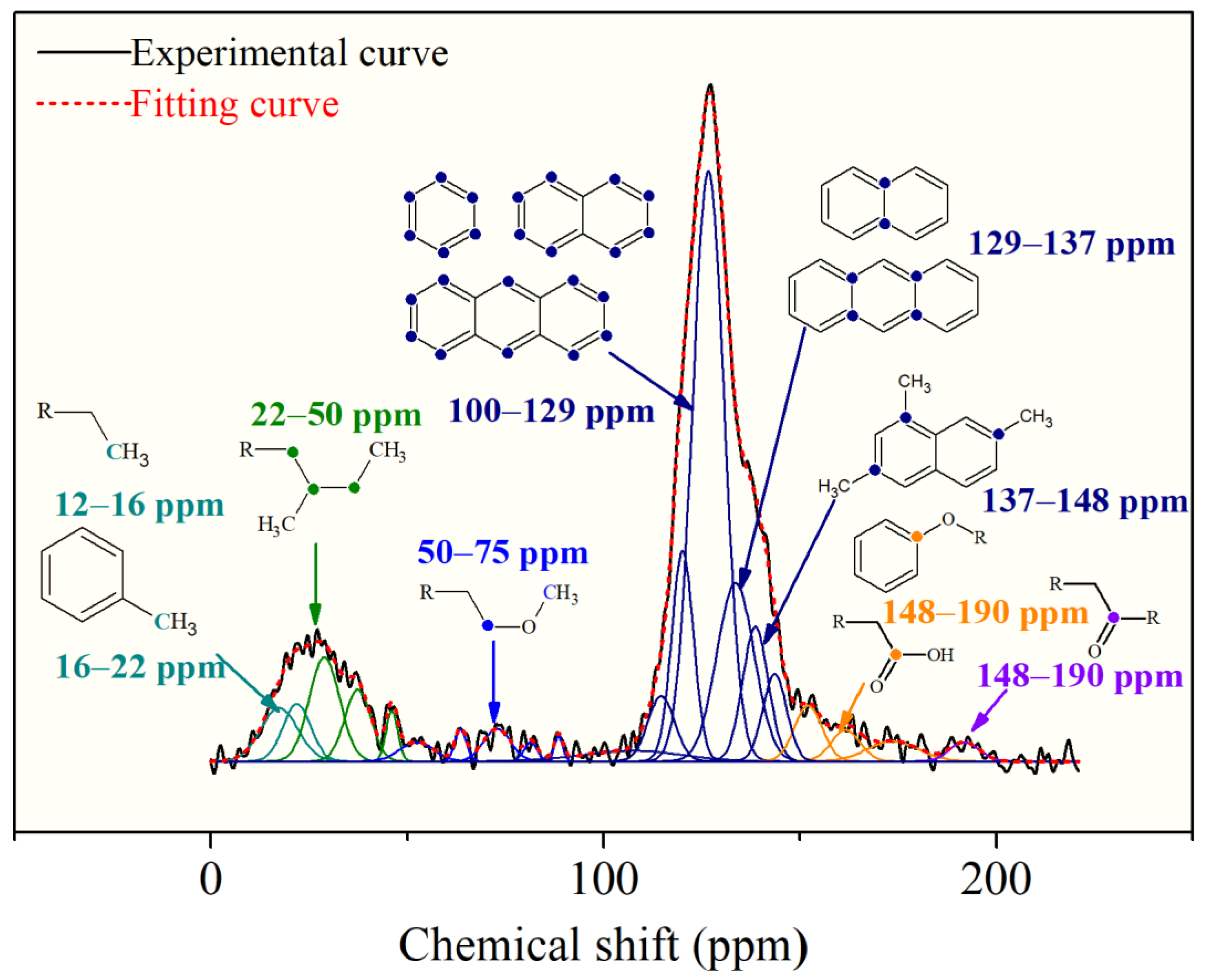
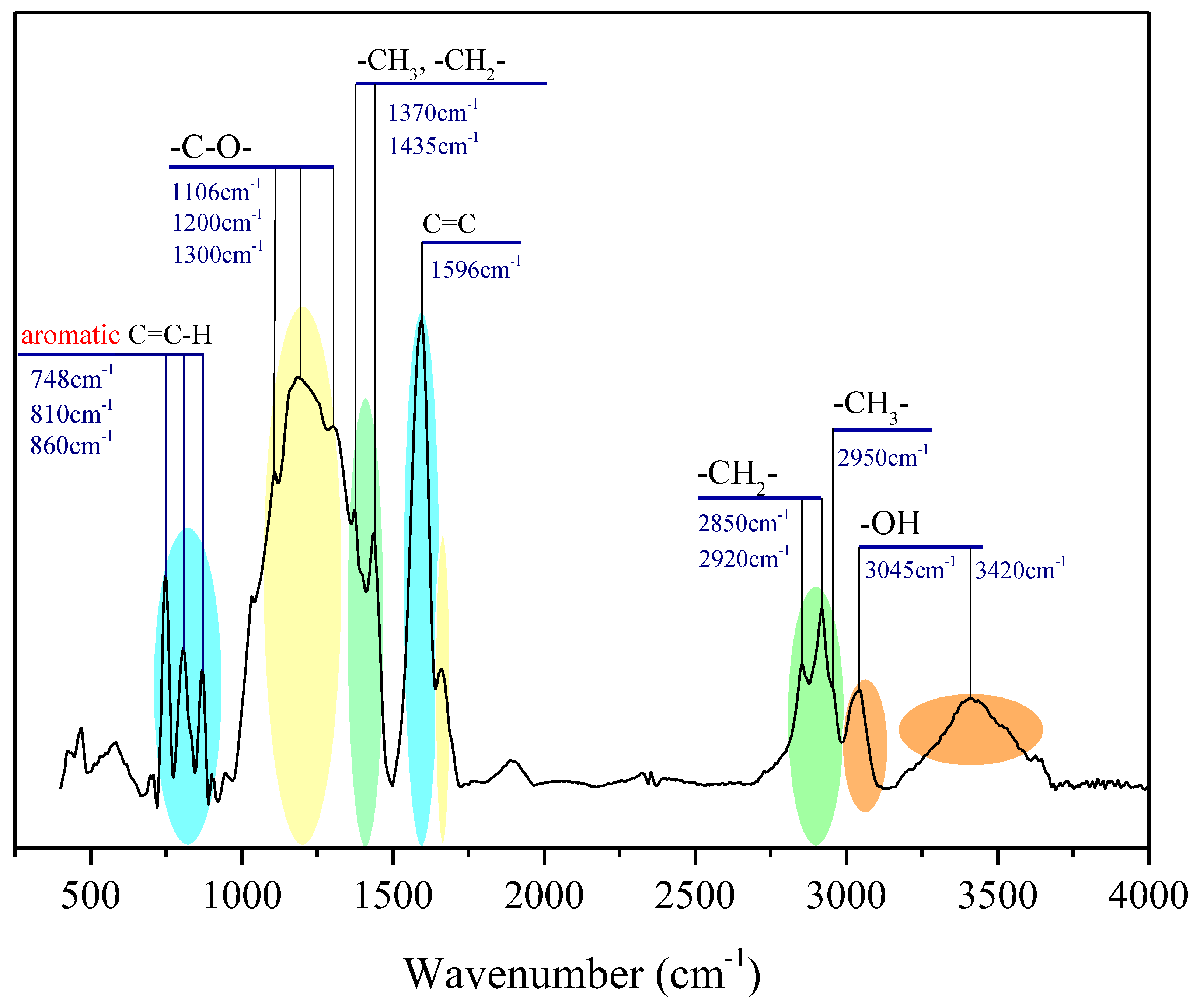
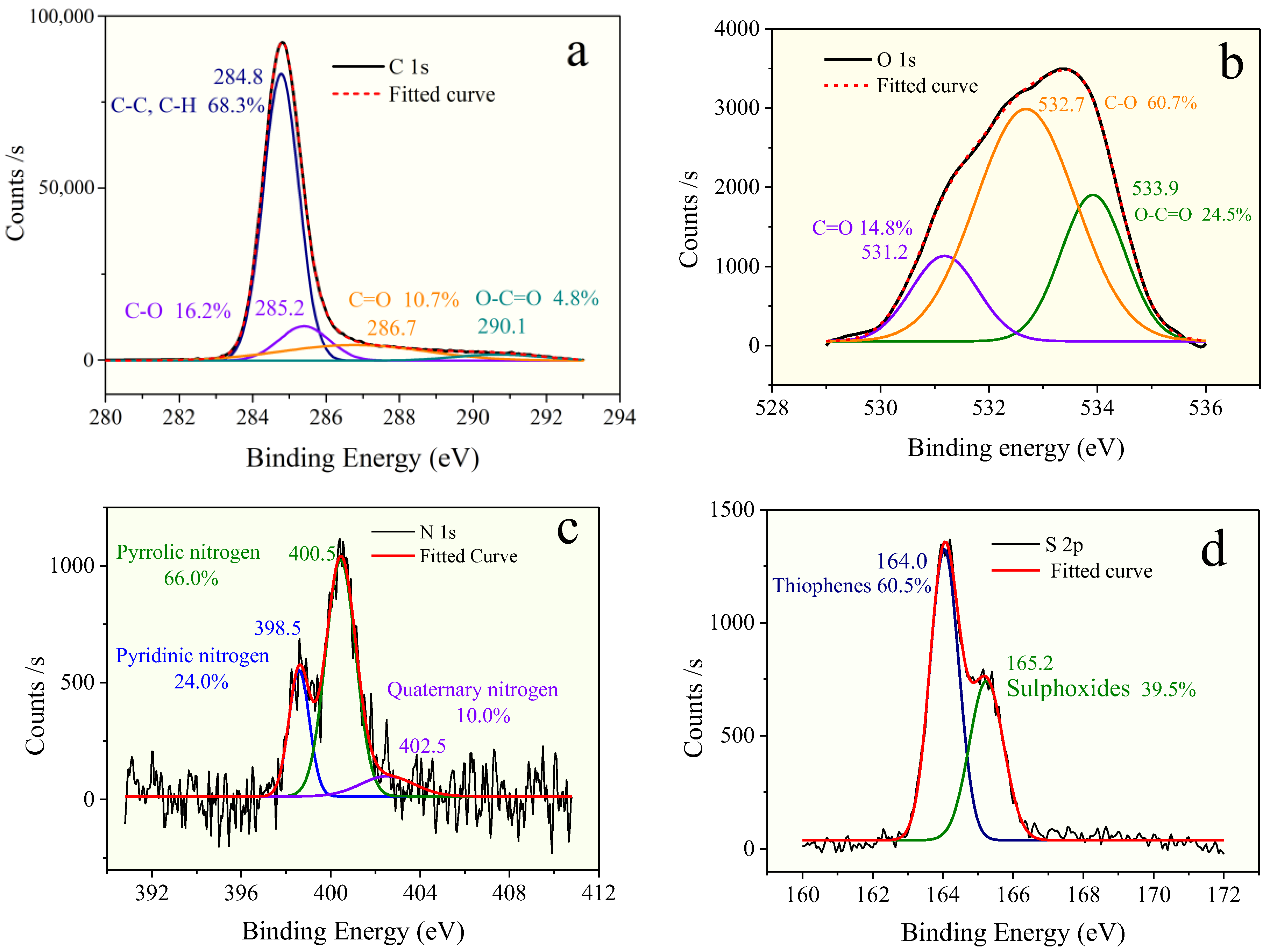
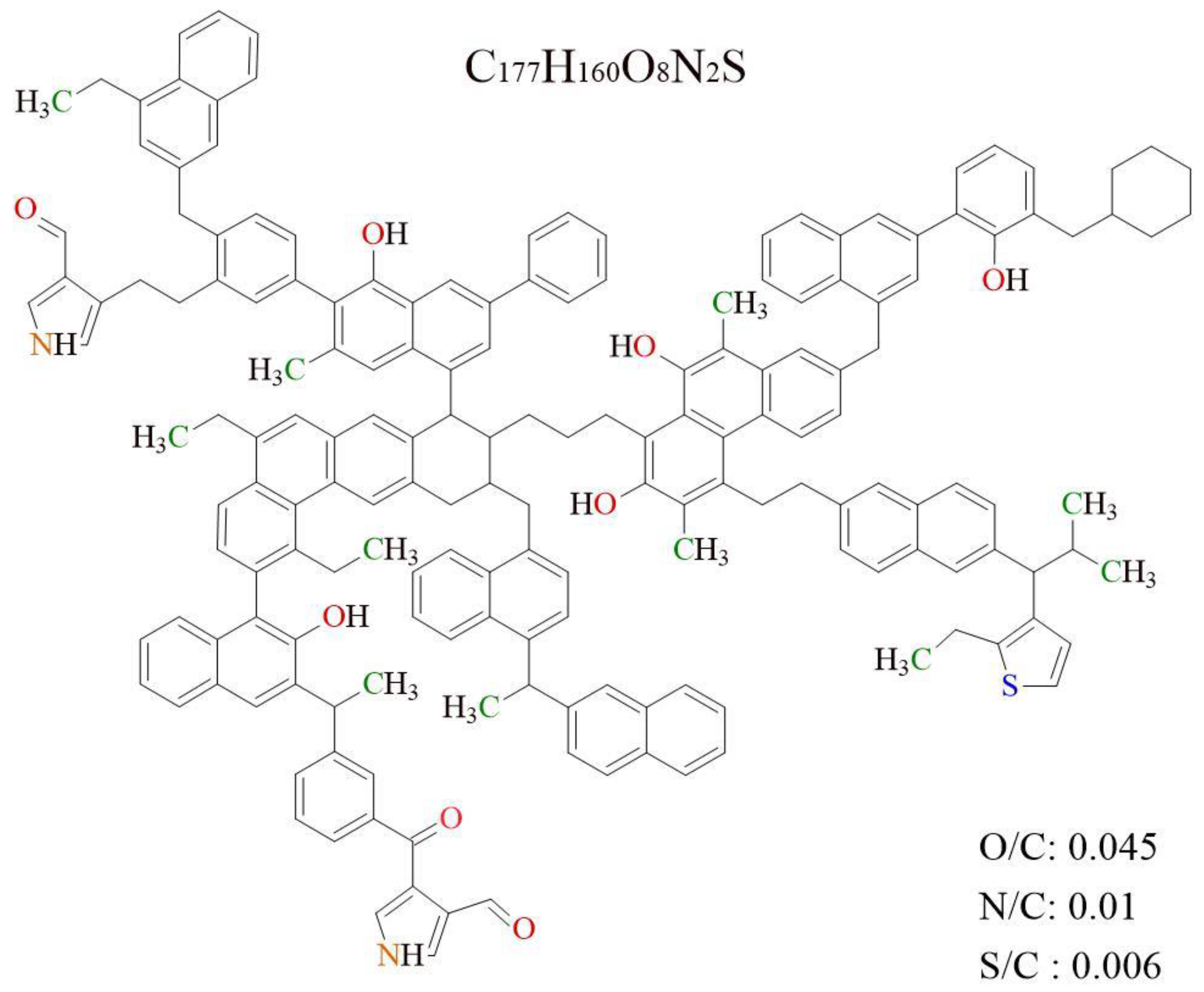
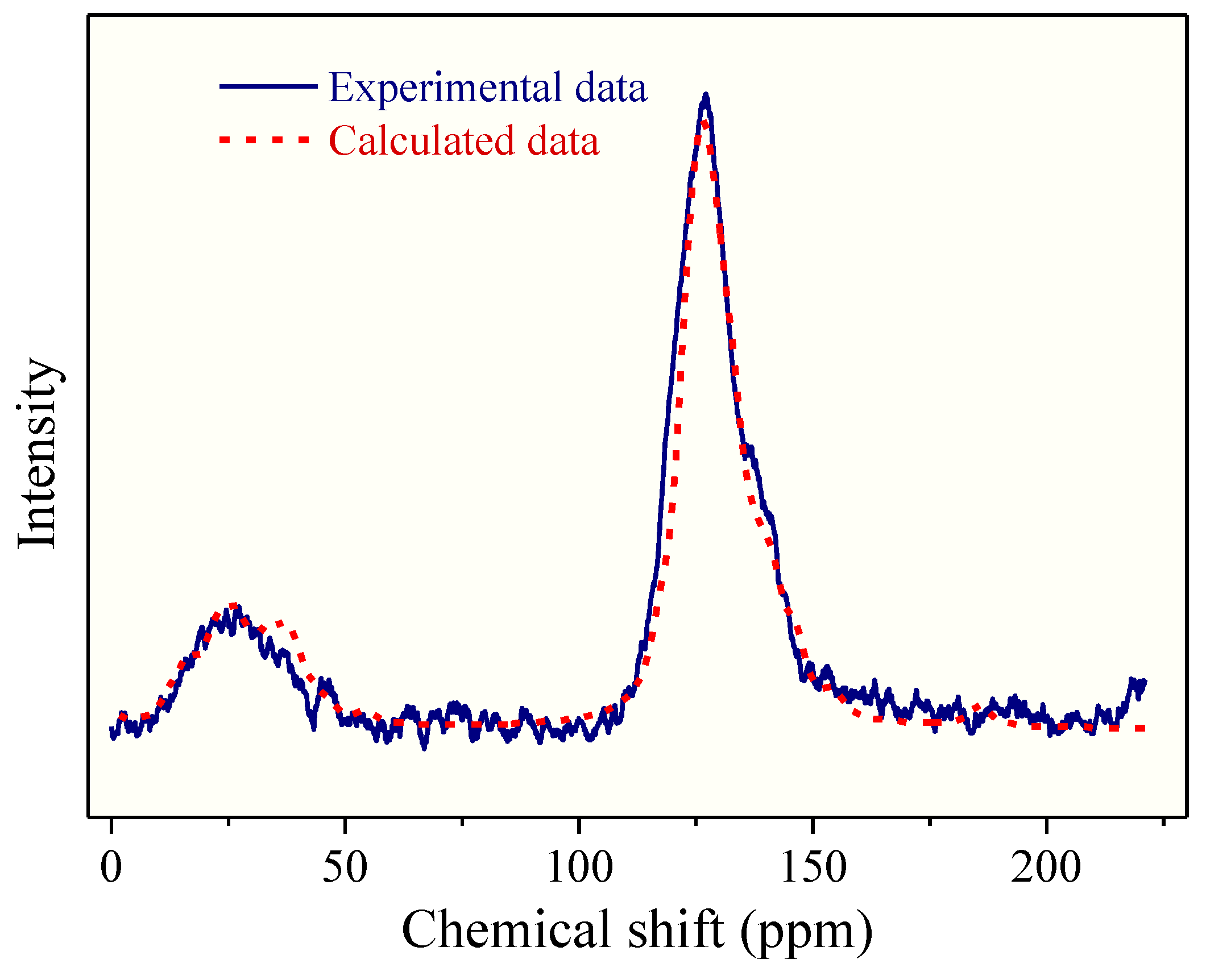
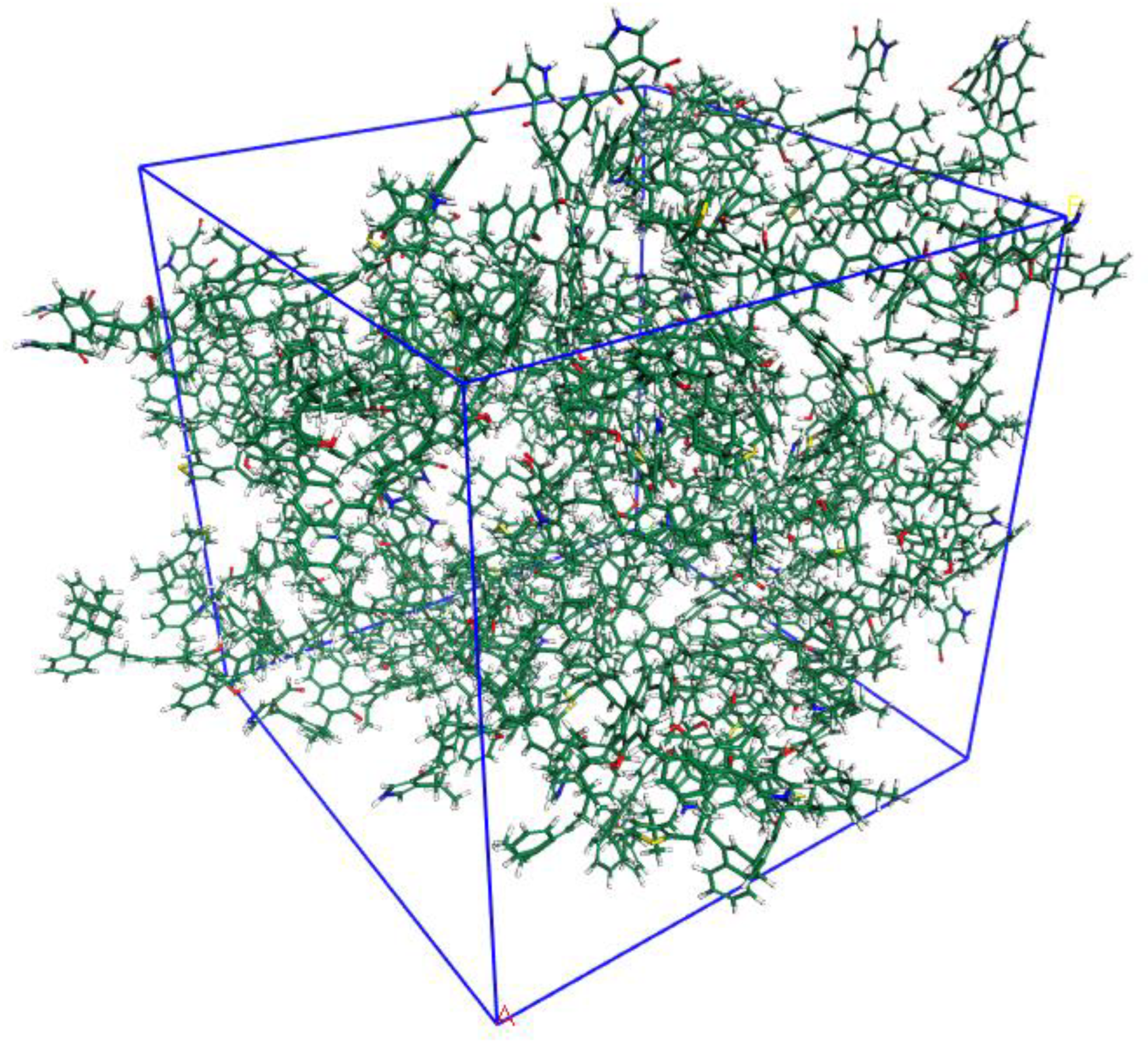

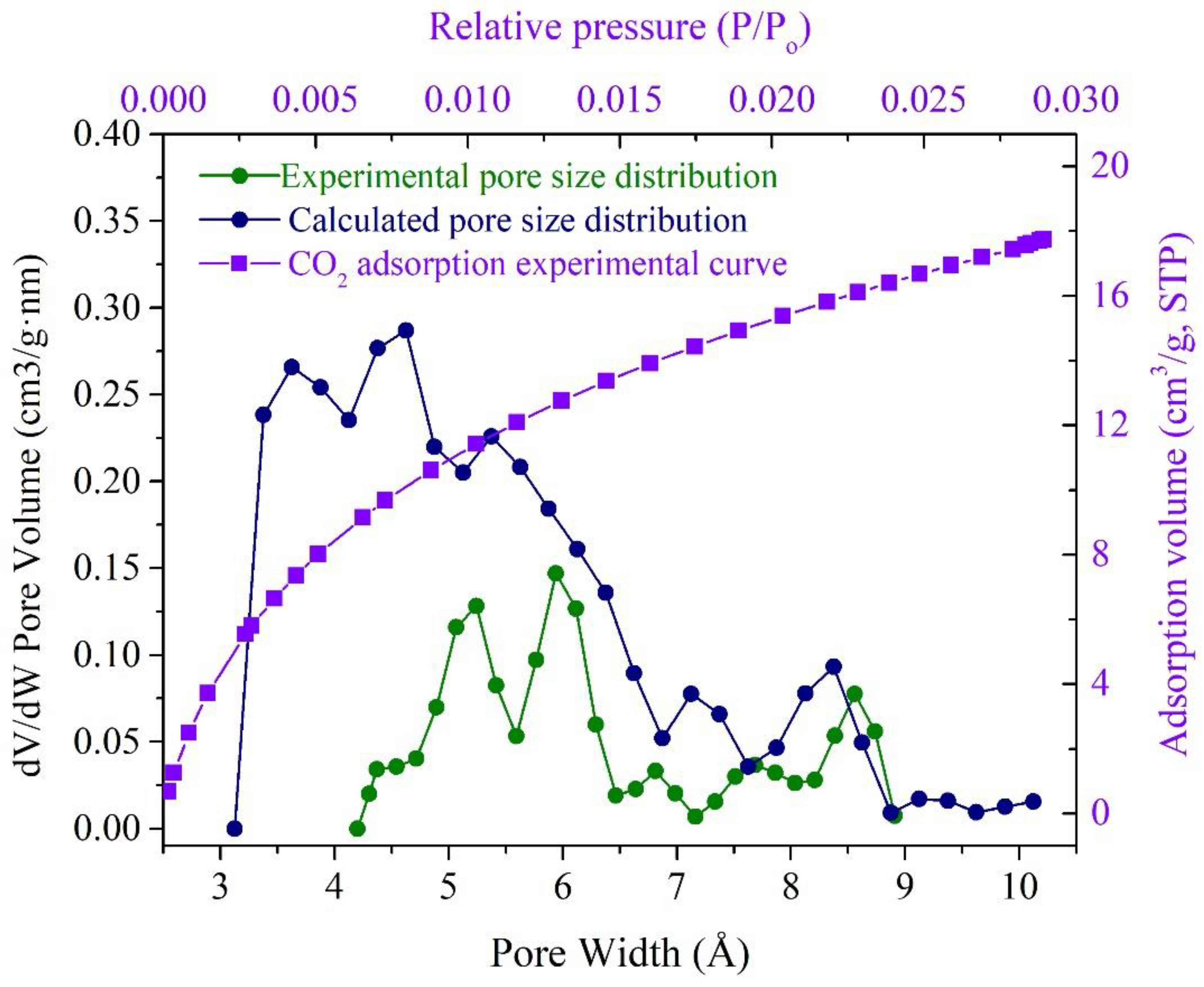
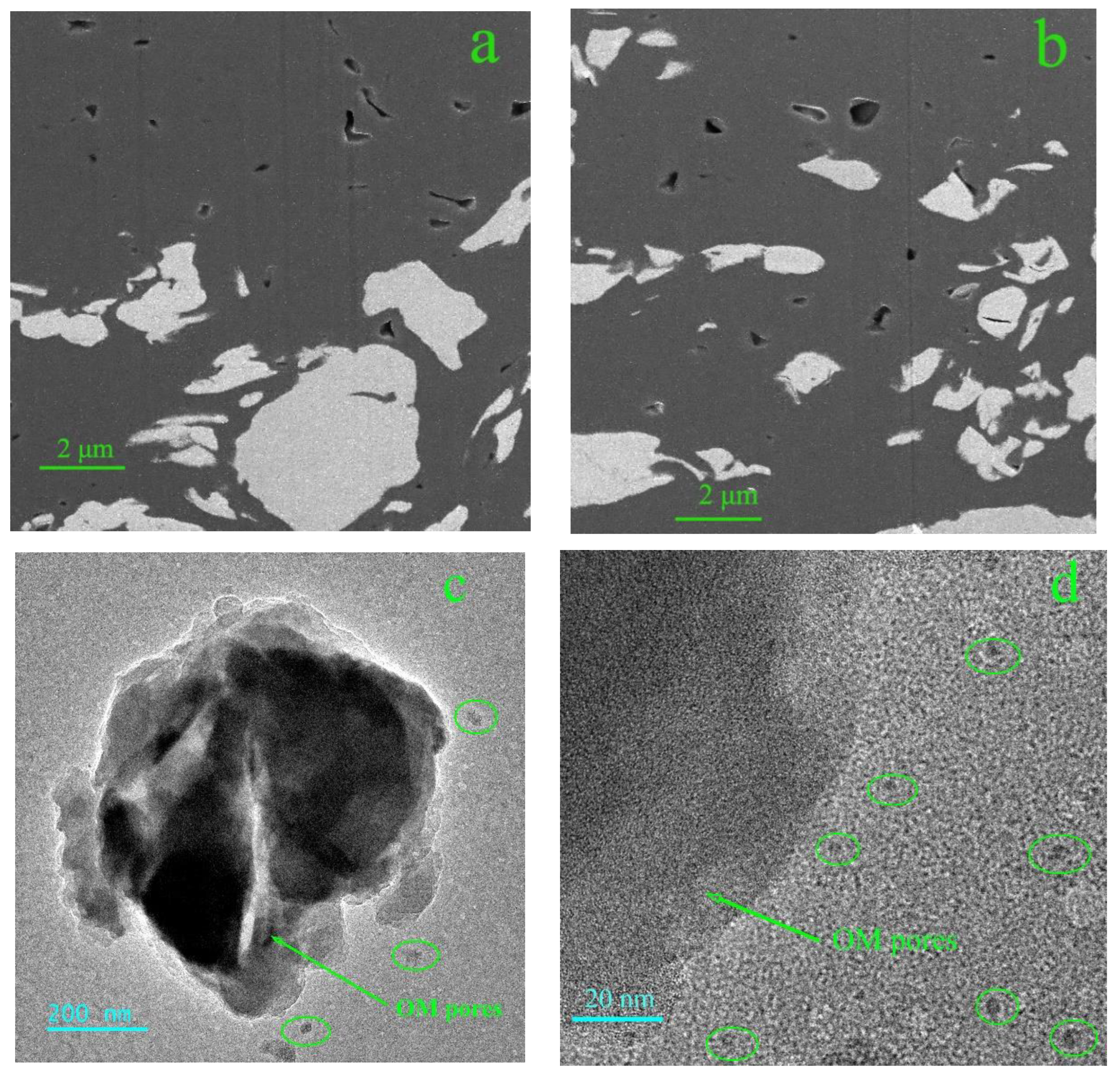
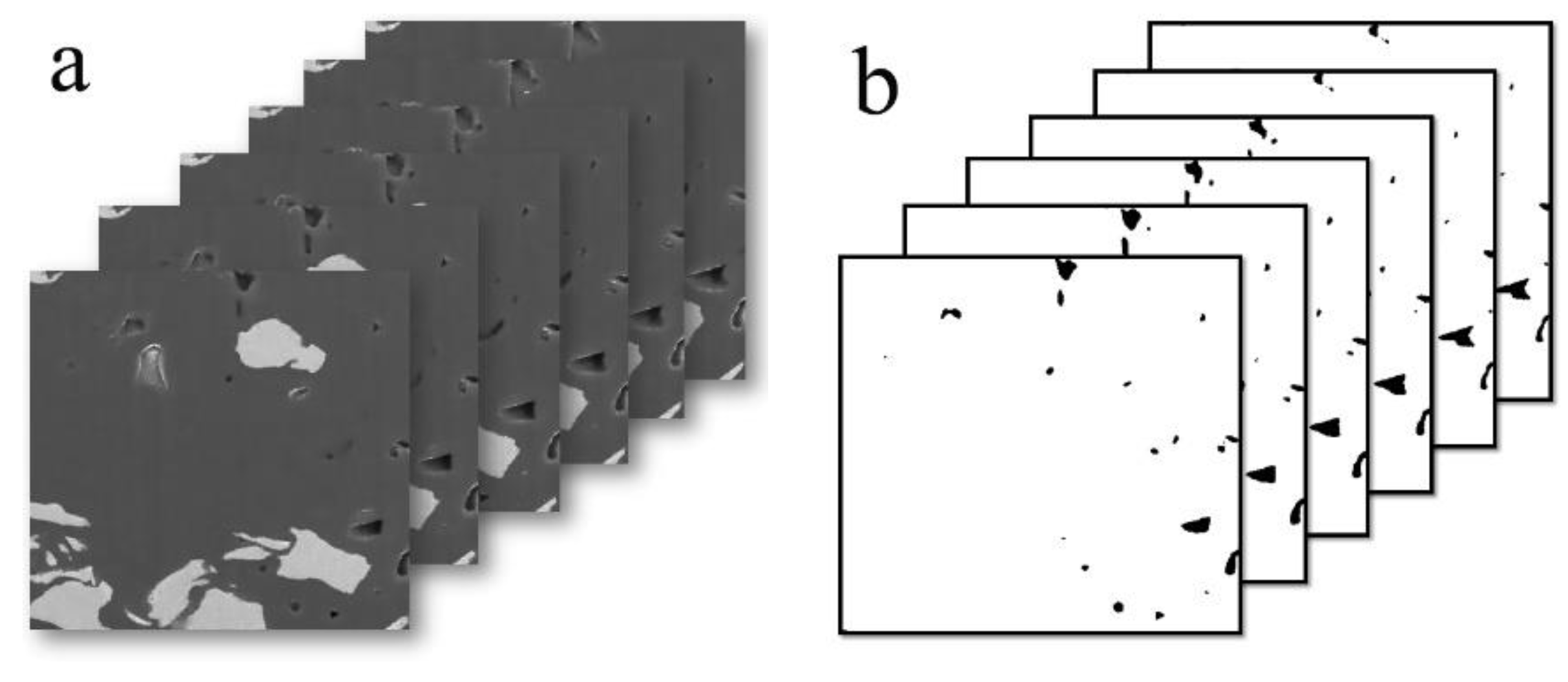

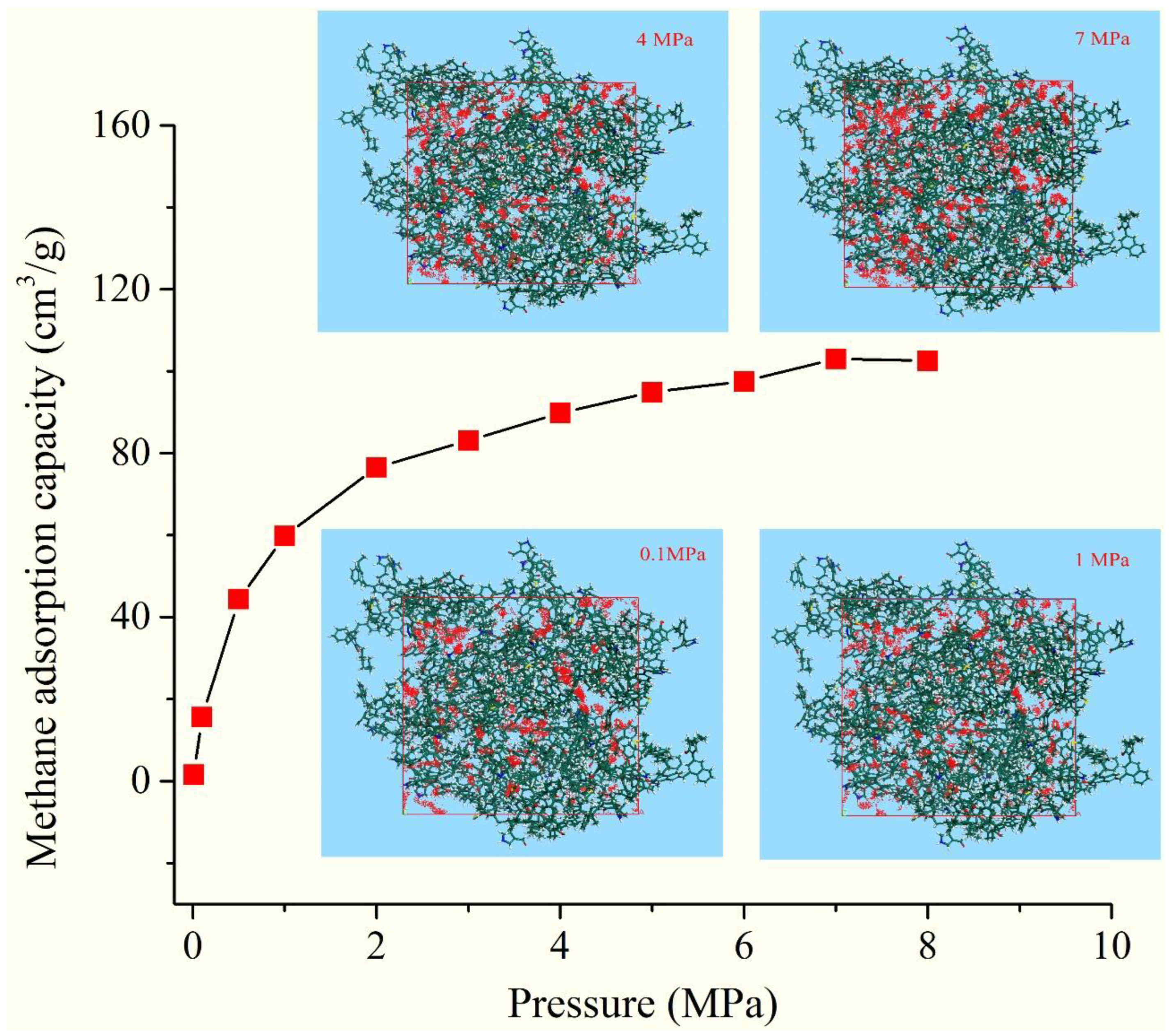
| Organic Matter | Atomic Ratio | |||||||
|---|---|---|---|---|---|---|---|---|
| C (wt%) | H (wt%) | N (wt%) | S (wt%) | O(wt%) | H/C | O/C | N/C | S/C |
| 87.61 | 3.71 | 1.2 | 1.89 | 5.51 | 0.51 | 0.047 | 0.012 | 0.009 |
| Type | Parameters for Aromatic Carbon | Parameters for Aliphatic Carbon | ||||||||||
|---|---|---|---|---|---|---|---|---|---|---|---|---|
| Parameters | fa | faC | fa’ | faN | faH | faP | faS | faB | fal | fal* | falH | falO |
| Chemical Shift (ppm) | >90 | >165 | 100–165 | 129–165 | 100–129 | 148–165 | 137–148 | 129–137 | 12–90 | 12–90 | 22–50 | 50–90 |
| Value (%) | 78.54 | 2.97 | 75.57 | 27.12 | 48.45 | 4.57 | 10.21 | 12.34 | 21.46 | 6.65 | 10.43 | 4.38 |
| XBP | 0.195 | |||||||||||
| Spectrum | Position (eV) | FWHM (eV) | Percentage (%) | Assignment |
|---|---|---|---|---|
| C 1s | 284.8 | 1.13 | 68.30 | C–C, C–H |
| 285.2 | 1.65 | 16.20 | C–O | |
| 286.7 | 3.35 | 10.70 | C=O | |
| 290.1 | 3.14 | 4.80 | O–C=O | |
| O 1s | 531.2 | 1.45 | 14.80 | C=O |
| 532.7 | 2.18 | 60.70 | C–O | |
| 533.9 | 1.39 | 24.50 | O–C=O | |
| N 1s | 398.5 | 1.09 | 66.00 | Pyridinic nitrogen |
| 400.5 | 1.59 | 24.00 | Pyrrolic nitrogen | |
| 402.5 | 2.82 | 10.00 | Quaternary nitrogen | |
| S 2p | 164.0 | 0.97 | 60.50 | Thiophenes |
| 165.2 | 1.15 | 39.50 | Sulphoxides |
| Type | Number | Type | Number |
|---|---|---|---|
 | 2 |  | 7 |
 | 4 |  | 2 |
 | 1 | XBP = 0.196 | |
| Samples | XS-01 | XS-02 | XS-03 | XS-04 | XS-05 | XS-06 |
|---|---|---|---|---|---|---|
| TOC (%) | 4.11 | 4.77 | 3.47 | 3.21 | 20.3 | 3.95 |
Disclaimer/Publisher’s Note: The statements, opinions and data contained in all publications are solely those of the individual author(s) and contributor(s) and not of MDPI and/or the editor(s). MDPI and/or the editor(s) disclaim responsibility for any injury to people or property resulting from any ideas, methods, instructions or products referred to in the content. |
© 2023 by the authors. Licensee MDPI, Basel, Switzerland. This article is an open access article distributed under the terms and conditions of the Creative Commons Attribution (CC BY) license (https://creativecommons.org/licenses/by/4.0/).
Share and Cite
Li, K.; Tian, H.; Liang, Y.; Guo, W.; Zhao, Y.; Meng, Y.; Kong, S. The Molecular Model of Organic Matter in Coal-Measure Shale: Structure Construction and Evaluation Based on Experimental Characterization. Molecules 2023, 28, 5203. https://doi.org/10.3390/molecules28135203
Li K, Tian H, Liang Y, Guo W, Zhao Y, Meng Y, Kong S. The Molecular Model of Organic Matter in Coal-Measure Shale: Structure Construction and Evaluation Based on Experimental Characterization. Molecules. 2023; 28(13):5203. https://doi.org/10.3390/molecules28135203
Chicago/Turabian StyleLi, Kunjie, Hongwu Tian, Yanxia Liang, Wei Guo, Yuqiong Zhao, Yanjun Meng, and Shaoqi Kong. 2023. "The Molecular Model of Organic Matter in Coal-Measure Shale: Structure Construction and Evaluation Based on Experimental Characterization" Molecules 28, no. 13: 5203. https://doi.org/10.3390/molecules28135203
APA StyleLi, K., Tian, H., Liang, Y., Guo, W., Zhao, Y., Meng, Y., & Kong, S. (2023). The Molecular Model of Organic Matter in Coal-Measure Shale: Structure Construction and Evaluation Based on Experimental Characterization. Molecules, 28(13), 5203. https://doi.org/10.3390/molecules28135203







